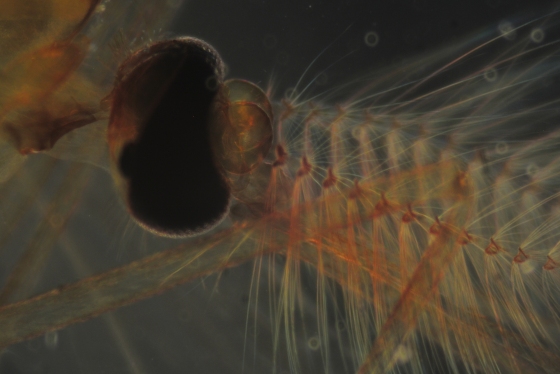For residents of the United States it’s been hard to ignore the alarmist “news” about the Zika virus this spring and summer. Like a number of tropical diseases it’s mosquito borne and the particular vector is Aedes aegypti.

Zika? No! This is a male and it’s the wrong species!
Individuals in northern areas may feel somewhat reassured by the fact that vector insect population data from the Centers for Disease Control shows only a scant few places where A. aegypti have become established. Well… that information is out of date at best and flat out wrong at worst. After all, this is the yellow fever mosquito we’re dealing with. Remember yellow fever, they used to all it the American plague, no one should be surprised that this particular mosquito is all over the place in North America.
Want some specific location data? I’ve been sampling populations in my area (at two locations one 30 miles East of Rochester, NY, the other a further 10 miles East of that) for a few years now just for fun. Wonder of wonder, there’s several species around, including A. ageypti. What’s better than my word? Your own hard data, lest we give in to the complacency of ignorance lets find out what mosquitoes we have in our own backyards!
I should point out that one doesn’t need a microscope to identify mosquito larvae, nymphs, or adults; but in each stage of development they’re wonderful subjects for the microscopist. Larvae (eggs too if you find them) and nymphs make wonderful live or preserved specimens. Newly killed adults may be examined nicely in temporary mounts. Permanent whole mounts in resinous media are only a little more involved. Unlike with other flying insect species, prepared slides of the mosquito life cycle are widely available, but they’re so simple to do at home anyone who isn’t in a mad rush should really consider it.
Obviously one will first need to get a quantity of mosquitoes. Before rushing outdoors to wait for a hungry little vampire in search of a blood meal to land on an arm (which is an option for the impatient) consider: a feeding mosquito will be female, will probably be damaged during capture, and must be suffered to bite. It’s a great deal simpler to collect mosquitoes with a live trap (for adults) or a turkey-baster (for larvae and nymphs). In fact, anyone with an empty jar can run out and collect hundreds of mosquitoes in an few hours, if they consider the aquatic larvae sufficient; and they are! Those larvae will become adults in short order.
This isn’t a series about how to prepare permanent mounts of the specimens, this is about how to get them, and observe them in temporary mounts. Some other time we’ll get into permanent mounts of mosquitoes for now the goal will be simple and three-fold:
- Locate a likely source of mosquito larvae, and collect some.
- House those larvae in a vessel in which they may mature through all stages of development.
- Sample and observe specimens from that vessel representing each stage.
Hey check it out I can be topical! -K